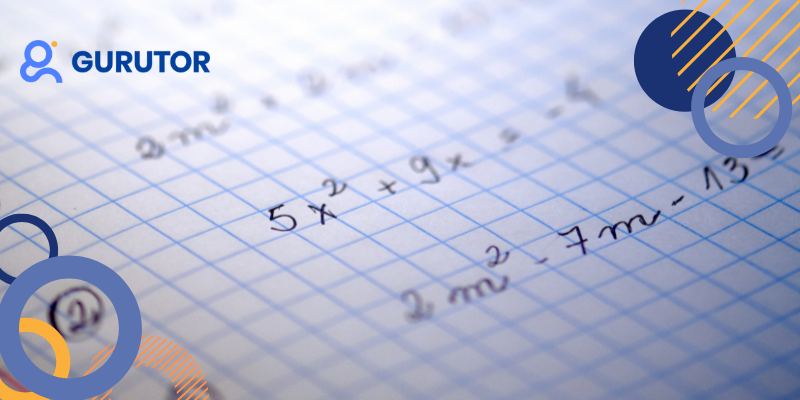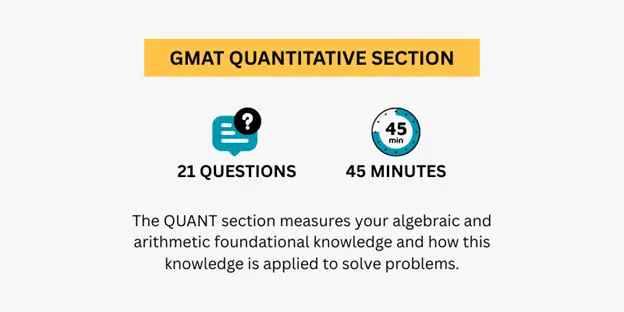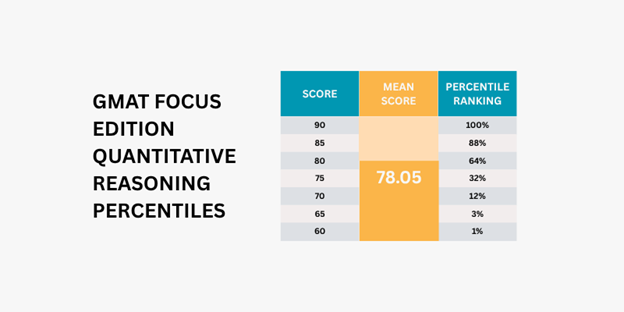GMAT Quantitative Reasoning Section

Does the word “Quant” make your stomach turn? You’re not alone.
For a lot of GMAT Focus Edition test-takers, the GMAT Quantitative Reasoning section feels like the biggest hurdle, especially if math hasn’t been your thing in a while (or ever).
But here’s the truth: you don’t need to be a math genius to do well.
You just need the right mindset, tools, and strategy.
You’ll be doing all your math the old-school way, with pencil and paper (no calculator allowed for this section), tackling questions in arithmetic, algebra, and logical reasoning.
In this guide, you’ll explore everything you need to know about GMAT Quant and how to build skills that won’t just help you on test day but also serve you in B-school and beyond.

Overview of the GMAT Quantitative Reasoning Section
The GMAT quantitative reasoning section consists of 21 multiple-choice Problem Solving questions, which must be completed within 45 minutes.
Unlike the older version of the GMAT, there’s no Data Sufficiency in this section anymore.
What it Measures: Algebraic and arithmetic foundational knowledge and how this knowledge is applied to solve problems.
Score Range: Quantitative Reasoning GMAT scores range from 60 – 90.
How it’s Scored: The Quantitative Reasoning score is based on three factors:
- The number of questions answered
- Whether the answers are correct or incorrect
- The difficulty and other parameters of the questions answered
You’ll solve everything with pencil and paper, no calculator allowed, so being comfortable with mental math and estimation can give you an edge.
Topics Covered in GMAT Quant
The GMAT Focus Edition Quant section sticks to the basics, but expects you to use them well.
So, what math is on the GMAT? There’s no calculus, no trigonometry, and no geometry.
Instead, it’s all about how well you can reason through high-school-level math, especially under time pressure.
Here’s what you’ll see:
1. Arithmetic (Fractions, Ratios, Percents, Averages)
Expect core number operations like fractions, decimals, percents, and ratios.
You’ll calculate percentage changes, average rates, and solve problems involving simple and compound interest.
Remember, quick mental math is very helpful here.
2. Algebra (equations, inequalities)
This is where you’ll work with linear and quadratic equations, inequalities, exponents, roots, and expressions.
You’ll simplify, rearrange, and solve for variables, often in the middle of a word problem. Systems of equations and algebraic fractions come up often.
3. Number Properties & Basic Stats
Know your primes, factors, multiples, odd/even, and remainders.
You’ll also handle basic statistics, such as mean, median, mode, and probability. These questions often rely on patterns and logic, not just pure calculation.
4. Word Problems & Data Analysis
Many questions are built around real-world contexts, such as work-rate problems, mixtures, proportions, and basic financial math.
While most charts and graphs are saved for the Data Insights section, you’ll still interpret some data in Quant, just in simpler, number-based formats.
5. Geometry? It’s Gone
Geometry has been mostly phased out of Quant in the Focus Edition.
You’re not expected to memorize area formulas or work with angles. At most, you might see a basic shape in a word problem, but it’s not a core focus anymore.
6. No Data Sufficiency
The old GMAT’s unique Data Sufficiency format is no longer part of the Quant section. That’s now in the Data Insights section.
Still, the reasoning skills behind DS, such as knowing when you have enough information, are useful across the entire test.
That said, the GMAT Quant isn’t about doing fancy math. It’s about using simple math strategically to solve harder problems.
So, basically: think logic, not formulas.
How Scoring Works for Quant
GMAT Quant difficulty plays a key role in scoring, which isn’t entirely transparent.
Your GMAT score depends not just on getting questions right, but also on how difficult those questions are.
Here’s what you need to know to get a high score:
Raw Score → Scaled Score (60–90)
Every correct answer bumps up your raw score.
Wrong or skipped questions don’t help or hurt directly, but they do cap your potential.
Then the GMAT algorithm converts your raw score into a scaled score from 60 to 90.
The catch? Harder questions count more.
So getting tougher items right can push your score higher than just getting lots of easy ones correct.
Adaptive by Question
The GMAT Focus Edition doesn’t split Quant into multiple parts; it’s one single 21-question block.
However, it still adapts in real-time: do well early, and the test starts feeding you harder problems.
Your performance across the whole section matters, but those first few questions may carry extra weight in shaping your path.
Equal Weight in Total Score
Quant, Verbal, and Data Insights each count one-third toward your overall score (205–805).
That means a weak Quant score can drag down your total just as much as a weak Verbal score. A strong Quant (think 85–90) can make a serious difference in your final result.
Percentiles Matter
The new Focus Edition uses a tighter score scale, so a score of 83 or above typically places you in the top 10–15% of test-takers.
For example, a Quant score of 86 = 90th percentile according to GMAC’s latest data.

Schools often consider percentiles, not just raw numbers, especially now that a score of 645 on the Focus scale is equivalent to a score of 700 on the old scale.
Strategies to Ace GMAT Quant
Scoring high on GMAT Quant isn’t about being a math genius.
It’s about building strong habits, knowing what to focus on, and practicing with purpose and strategy.
Here are the GMAT Quant strategies to level up your game:
1. Strengthen Your Basics
Solid arithmetic and algebra skills are non-negotiable.
Be fluent with fractions, decimals, percentages, ratios, and equations.
Many mistakes on test day happen on the “easy stuff,” so drill those fundamentals until they’re second nature, especially under time pressure.
2. Prioritize High-Yield Topics First
Focus on the ones that show up the most: percent/rate problems, work-rate, ratios, linear/quadratic equations, number properties.
Geometry is barely tested, so you don’t need to spend much time there. Target your weaknesses, but start with what moves the needle.
3. Get Comfortable with Word Problems
The math isn’t always hard, but the wording can be.
Practice translating text into equations. Look for keywords, define variables clearly, and visualize setups when needed.
Remember, most Quant questions are just real-world scenarios hiding simple math behind extra words.
4. Time Management = Score Management
You’ve got 21 questions in 45 minutes. That doesn’t mean exactly 2 minutes per question, some will take more, others less.
Aim to get through the first 10–12 questions in the first half of the section.
Plus, learn to spot time-sinks, and don’t be afraid to guess and move on if you’re stuck.
5. Borrow Logic from Data Insights
Even though Data Sufficiency is now in the Data Insights section, the reasoning skills still help.
Get in the habit of asking: “Do I have enough to solve this?” Practicing old-school DS problems can sharpen your logic and improve your approach to Quant overall.
6. Use Official GMAT Materials
No source is more accurate than GMAC’s own materials. Use the Official Guide, practice exams, and the Focus Edition Starter Kit.
7. Drill + Review = Real Progress
Set up regular practice blocks: 10–20 questions timed, followed by deep review.
Track mistakes and look for patterns.
Are you slow on algebra? Struggling with rates? Use flashcards for formulas, and keep cycling through tricky GMAT Quant topics.
8. Simulate the Real Thing
Take full-length practice exams to build stamina and get used to the digital whiteboard and no-calculator environment.
After each mock test, spend real time reviewing your misses; this is where the best learning happens.
Now that you’ve got the GMAT strategies, the next step is putting them into action, and that’s exactly what Gurutor is built for.
Everything we just talked about, high-yield topics, timing practice, word problem decoding, smart review, it’s all baked into the platform.
From real-time feedback to official-style questions and targeted drills, Gurutor keeps you focused on what actually moves your score.
So, if you’re serious about improving Quant, this is where you turn strategy into results.
Common GMAT Quant Pitfalls & How to Avoid Them
Even strong test-takers fall into avoidable traps on Quant.
Here’s what to watch for, and how to avoid the pitfalls while preparing for the GMAT Quant Section:
Overcomplicating the Math
GMAT questions often hide simple math behind messy wording. Don’t dive into heavy algebra too fast; look for shortcuts like plugging in numbers, back-solving, or eliminating choices logically.
Careless Arithmetic Errors
With no calculator, small slips can cost you. Double-check signs, fractions, and basic calculations, especially when answer choices are close.
Misreading the Question
Don’t get distracted by extra info.
Read the question stem carefully and underline what’s actually being asked. Define your variables clearly and don’t assume anything that isn’t stated.
Looking for Data Sufficiency Tricks
In Focus Edition Quant, every question has a definitive answer. Don’t waste time wondering if there’s “enough info.” That mindset belongs in the Data Insights section.
Passive Studying
Watching videos is helpful, but not enough. You need to solve problems to build speed and accuracy actively. Practice is where real improvement happens.
Avoiding Weak Spots
Don’t dodge your problem areas. Tackling tough topics head-on, like probability or word problems, can lead to some of your biggest score gains.
Most importantly, most GMAT Quant mistakes come from rushing or overthinking, not from the math itself.
Practice Plan for GMAT Quant Mastery
A strong Quant score starts with a structured plan and consistent practice, whether you’re taking the exam for the first time or coming back for the GMAT retake.
Here’s a focused 4-week study plan to sharpen your fundamentals, build speed, and boost confidence:
Week 1 – Build the Foundation
Begin with the basics: fractions, decimals, ratios, percentages, and fundamental algebra concepts.
- Watch quick lessons or review concept sheets.
- Practice 50–100 mixed questions to build variety and reinforce mental math.
- Focus on accuracy and clean calculation; these are the tools you’ll use throughout.
Week 2 – Master High-Yield Topics
Shift to topics that show up often: linear equations, inequalities, and word problems (rates, mixtures, interest).
- Learn time-saving strategies, such as back-solving or working with ratios.
- Do another 100+ questions, timed in small sets.
- Take a brief diagnostic quiz (e.g., a 30-question Quant mini-test) to assess your progress.
Week 3 – Push into Advanced Practice
Add more difficult topics: quadratics, exponents, number properties, and basic probability.
- Practice mixed sets under time pressure (simulate 45-minute Quant blocks).
- Take your first full-length Focus Edition GMAT practice test under realistic conditions.
- Track pacing, stamina, and question types that slow you down.
Week 4 – Review, Refine, and Simulate
Focus on reviewing weak spots identified in your mock test.
- Do targeted practice on problem areas.
- Take at least one more full-length practice exam with full timing rules.
- Continue with short daily sets (20–30 questions) to stay sharp between mock exams.
Note: Feel free to adjust the timeline and starting point as needed.
Review every single question you miss or guess. Don’t just mark it wrong and move on.
Ask yourself: Was it a concept gap? A careless error? Time pressure?
This kind of reflection is where real score growth happens.
And the good news? Gurutor already builds this into your prep.
Every practice session includes step-by-step feedback, performance insights, and error analysis, so you’re not just practicing, you’re improving.
It’s like having a tutor watch over your shoulder, helping you fix your blind spots in real time.
Resources to Boost Your Quant Score
Take advantage of high-quality materials, such as:
1. Official GMAT Materials
Start with the GMAT Official Guide (Focus Edition) and Official Practice Exams. These include real, retired questions and detailed GMAT score reports that highlight your areas of weakness.
2. Gurutor – The 24/7 Tutor You Actually Need
Most courses give you content, but Gurutor builds a structured learning system that guides how you study, not just what you look at.
That means personalized pacing, feedback loops, and adaptive support that mirrors the guidance of a top tutor, but is always available.
No hourly fees or surprise charges—just steady support.
3. Top Prep Books
Here are some top prep books to consider:
- Manhattan Prep Advanced Quant: Great for advanced strategies (still relevant despite being pre-Focus Edition).
- Kaplan Math Workbook or Pillai’s GMAT Math: Solid for content review and drills.
- Official Guide Series: Includes question sets by difficulty level.
But here’s the truth: Even the best books can’t give you feedback. They can’t spot your habits, correct your logic, or tell you where you’re wasting time.
4. Study Groups & Forums
GMAT Club and similar forums can help with peer explanations, but always verify advice against official sources.
FAQs About GMAT Quant
How many Quant questions are on the GMAT?
In the GMAT Focus Edition, the Quantitative Reasoning section includes 21 questions to be completed in 45 minutes. These are all Problem Solving multiple-choice questions, no Data Sufficiency anymore (that’s moved to the new Data Insights section).
What is a good Quant score?
A good Quant score on the GMAT Focus Edition typically falls in the upper‑70s to mid‑80s (i.e., scaled 78–85), placing you between approximately the 65th and 88th percentiles, a range that signals solid quantitative proficiency. Since section scores (60–90) are equally weighted in your overall 205–805 score, achieving an 85+ in Quant significantly boosts your competitiveness with target schools.
How hard is the Quant section?
The Quant section can feel tough, especially if you’re out of practice with math. While it only tests high school–level concepts, such as arithmetic, algebra, and basic word problems (excluding calculus and trigonometry), the questions are often tricky and require sharp reasoning under time pressure (mba.com). Expect a mix of easy, medium, and hard problems; hitting your target score requires getting most of the easy/medium ones right and a fair share of the hard ones.
Can I skip Data Sufficiency?
In the GMAT Focus Edition, Data Sufficiency questions are no longer part of the Quant section; they’ve been moved to the Data Insights section. That means in Quant, you’ll only face standard problem-solving questions, each with one correct answer.
How soon should I start Quant prep?
It’s best to start early. If your math skills are weak, plan for 3–4 months of preparation. If you’re already strong in Quant, 6-8 weeks of focused study may be enough. In general, aim for at least 2–3 months to prepare effectively without rushing.
